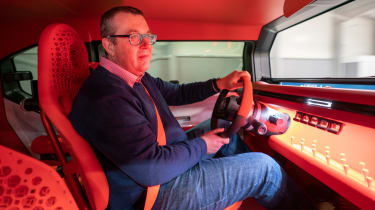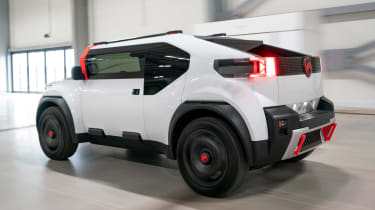Citroen Oli concept: design, specs and prototype review
Inspired by the spirit of the Citroen Ami, the Oli concept hints towards future vehicles with a pickup bed in the back and cardboard panels
- New Citroen badge arriving in 2023
- Oli concept features interchangeable exterior panels
- We’ve driven the prototype
The Citroen Oli is a concept car that would cost around £22,000 if it went into production, and we’ve had a go in the prototype to see what the future could herald. Oli showcases new lightweight technology for the brand, along with Citroen’s new branding for 2023. Using the new Citroen Ami quadricycle as inspiration, the Oli has a 40kWh battery, a simple design, and a focus on sustainability while maximising mobility. Unique features include a pickup bed for storage.
Although Citroen has stated the Oli is unlikely to reach showrooms, it instead hints to car buyers what future styling and features they can expect from Citroen. The styling, badges, and technical achievements are intended to flow through to future Citroen vehicles and so while you may not be able to buy the Oli, you may see the honeycomb cardboard panels, vertical windscreen, and boxy design language on production models.
It would be hard to miss an Oli passing you on the street; its 20-inch wheels, pickup bed rear with split tailgate, flat windscreen and frontal area flanked by squared C-Shape lights add up to a striking appearance. Channels in the headlights funnel air over the front screen, and the windows are designed to reflect the sun’s rays, reducing the need for air-conditioning.
Inside, it blends future technology with physical toggles for the climate control, a slim screen and speakers that connect to a smartphone, and seats built using 3D-printed mesh similar to an Adidas trainers sole, said to contain 80% less parts than a conventional seat.
The Oli is intended for city use with a top speed of just 68mph, but thanks to an efficient powertrain and lightweight, it can achieve 249 miles on a charge, and be topped up from 20% to 80% in just 23 minutes. The vertical windscreen and boxy aesthetic is a departure from the smooth lines of many new electric vehicles, which are designed with aero efficiency in mind to boost range. However, Citroen believes that because the Oli would be mainly used in low speed city traffic, the impact is minimal. Although higher speed running would be compromised the firm believes Oli would boast an efficiency figure of 6.2 miles per – the current Kia Niro EV manages 5 miles per kWh for comparison.
Sustainability was clearly a key aspect of the Oli design. The cardboard body panels are 50% lighter than steel ones. The side windows pop out, the wheels are a mix of steel and aluminium to save weight, and its tyres – created with Goodyear – are claimed to be capable of 50,000 miles before needing changing. Even its white paint is water-based and customisation is limited to vinyl stickers and interior trims.
Citroen has dubbed the Oli a ‘Swiss army knife’ because of its versatility, which includes vehicle-to-load capability, so its battery can power or charge up other electrical devices.
Although we don’t expect to see the Citroen Oli in showrooms, Citroen’s new badge will definitely appear in 2023, and we can expect to see some of the Oli’s features on other Citroen cars in the years ahead.
Citroen Oli prototype review – John McIlroy
The Oli’s interior feels pretty spacious up front, helped by an ultra-slim display that spans the dash. But there’s a lot of red in here; the seats, which feel comfy enough but are perhaps a bit short on sideways support, are the same vibrant shade as much of the front structure, which includes a storage area lined with rubber plugs to help hold items in place.
We’re not here to test the Citroen’s performance, of course, but rather to experience how the novel cabin and windscreen arrangement works. It’s a little odd to see three small windscreen wipers out front, but the environment itself becomes familiar in an impressively short amount of time.
Visibility out of the vertical screen is excellent, making it easy to place the front of the Oli within the confines of the hall. We’re aware of a bit of internal reflection in the curved door glass, caused by the building’s overhead lights, and the concept’s steering is typically slow. But with more effective assistance in place, the Oli would surely be an easy car to drive around town.
Would it be up to journeys out of town? The proposed range would suggest yes, but that sub-70mph top speed might be an issue on motorways. However, what the Oli does demonstrate is how the principles underpinning the Ami could be further developed and expanded to provide a sustainable, practical vehicle with the potential for much wider everyday usage. It could even be an interesting alternative to the raft of more affordable B-segment EVs that are on the horizon.
Interested in the Citroen Oli but want an electric car you can buy now? Check out our 10 best electric cars, or if you’re on a tight budget, see our top 10 cheapest electric cars.
Recommended

Suzuki’s new 10-year warranty is free – here’s how to get it

Volkswagen Black Editions: T-Cross and Tiguan get a stylish upgrade

About to spend £60k on an Audi Q6 e-tron? Try these alternatives and save over £20k

Peugeot 3008 plug-in hybrid joins the lineup, starts from around £40k
Most Popular

Suzuki’s new 10-year warranty is free – here’s how to get it
Tips & advice

Car dashboard warning lights: what does each symbol mean?

Electric car charging stations: public networks, charger types, apps and maps













